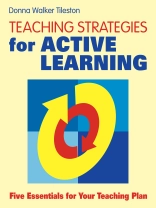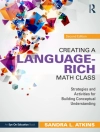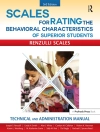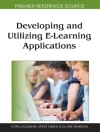’Emphasizes the importance of matching instructional strategies to the appropriate outcomes.Thia is very important!’
—Cindy Harrison, Educational Consultant
’My peers would benefit from having this handbook to guide new and struggling teachers and to inspire the expert teacher on staff. Practical suggestions give educators incremental steps toward increasing the active learning level within any classroom, without giving up control of content.’
—Beverly C. Eidmann, Principal, Arvada Middle School, CO
Make a difference in student learning with the latest and best brain-based teaching strategies!
Translating brain research into best practice, Donna Walker Tileston, award-winning author, educator, and trainer, offers teachers a simple and concise Strategic Learning Model applicable to all grade levels, content areas, and instructional settings. This systematic cycle focuses on five essentials that teach learners to plug in, power up, synthesize, outsource, and reflect on their learning.
Based on the latest brain and educational research, this student-centered, teacher-friendly guide includes:
- A carefully chosen collection of instructional strategies for promoting the active transfer of knowledge to students′ long-term memory
- A step-by-step process for planning powerful lessons that make a difference in student learning
- Sample lesson forms and reproducible templates
- Sample strategies such as question-and-answer profiles, technology integration, mindjogs, KNLH, group memory, making predictions, cooperative learning, six-hat thinking, collaborative retelling, graphic organizers, thinking at right angles, plus-minus-interesting, and much more
This is the teaching methods book for all teachers, instructional leaders, and curriculum designers who want to build students′ motivation, confidence, self-efficacy, and achievement.
Innehållsförteckning
Preface
Does the Strategy Follow Current Brain Research?
Acknowledgments
About the Author
1. Teaching in the 21st Century
Elements of the Strategic Learning Model
The Teacher’s Role
2. Plugging In
Part 1 of the Model: Plugging In
Self-Efficacy as a Key to Motivation for Learning
Activities for Building a Sense of Community in the Classroom
Integrating Technology as a Tool for Building Community
Summary
What Does the Research Say?
3.Powering Up
Beginning With the Self-System of the Brain
Mind Jogs
Building Connections
Summary
What Does the Research Say?
4. Synthesizing
The Metacognitive System
Building Declarative Knowledge
Summary
What Does the Research Say?
5.Outsourcing
Concrete Models
Brainstorming Models
Thinking in Categories
Summary
What Does the Research Say?
6. Reflecting
Summary
What Does the Research Say?
Resources
Resource A: Sample Lesson Forms
Resource B: Blackline Masters
References
Index
Om författaren
Donna Walker Tileston is a veteran teacher and administrator. She is currently the president of Strategic Teaching and Learning, a consulting firm that provides services to schools throughout the United States and worldwide. Donna’s publications include Ten Best Teaching Practices: How Brain Research, Learning Styles, and Standards Define Teaching Competencies (2000), which has been on Corwin′s bestseller list since its first year in print, in addition to the ten-volume award-winning series What Every Teacher Should Know, now in its second edition. Other recent titles are Teaching Strategies for Active Learning (2006), Teaching Strategies that Prepare Students for High Stakes Tests (2008), and Closing the Poverty and Culture Gap (2009). Donna received her BA from the University of North Texas, her MA from East Texas State University, and her Ed D from Texas A & M University-Commerce. She may be reached at www.whateveryteachershouldknow.com












